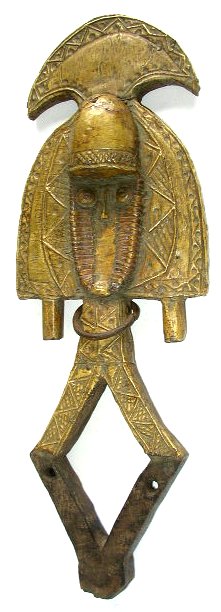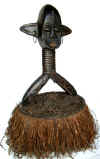 |
 |
|||
TRIBAL AFRICAN ART
KOTA (AKOTA, BAKOTA, KUTA)
Gabon and People's Republic of the Congo
The land of the Kota, numbering some 75,000, is situated in the
eastern part of Gabon, extending slightly into the People’s Republic of the Congo.
The Kota are actually a number of groups of peoples with common cultural traits. Although
these peoples share many cultural traits, they are by no means homogeneous. The rain forests which surround the Kota are farmed with slash and
burn techniques, combined with crop rotation. By moving crops from year to year, erosion
and soil depletion is avoided. The main crops grown are plantains and manioc.The Kota live in villages comprising two or more clans. Clans in
turn comprise several lineages or family groups that trace their descent from a common
lineage ancestor. This is an important point related to their art, for like the Fang, the
Kota revere the relics of ancestors. Ancestor worship formed the core of the family
group’s religious and social life. At the death of a chief, the initiates would take
from the body of the deceased various relics, which were then decorated with metal and
rubbed with powders of multiple magical powers. The Kota have produced large quantity of
statues of ancestors with the
diamond-shaped lower part called mbulu-ngulu; these
rather two-dimensional sculptures are in wood;
symbolic metals were applied to the upper part in strips or sheets to add power. Copper in
particular was identified with longevity and power. These statues stood guard in
cylindrical bark boxes, on baskets or bundles called bwete
that
contained the skulls and bones of important ancestors. Bound into a packet and lashed to the base of a carved figure, the
bones formed a stable base that allowed the image to stand more or less upright. Thanks to
the diversity of the groups, scattered over a vast area, a great variety of different
styles of figures has developed, some of them endogenous and some influenced by
neighboring styles. Kota figures represent an extremely stylized human body, reduced to
shoulders and “arms,” in emptied lozenge shape, surmounted by a large face
framed by an ample coiffure with hanging tresses. The face, always oval, may be concave
(female), convex (male) or concave-convex, with a forehead in quarter-sphere (also male).
The reliquaries were kept outside the homes, in huts at the edge of the village. Only the
initiates of the lineage had access to this sacred place. At the time of initiation in the
reliquary cult, the clans would meet to perform communal rituals; each clan’s chief
would dance holding the reliquary. Some reliquaries featured a large figure representing
the lineage founder along with some smaller figures representing his successors.
The bwete was called on in time of crisis to combat unseen
agents of harm. Its intercession was sought in such vital matters as fertility, success in
hunting, and in commercial ventures. A husband could use it to guard against his
wife’s infidelity, for it was believed that if he placed pieces of her clothing in
the reliquary, an unfaithful wife would be driven mad. Families took their bwete to
ceremonies of neighboring villages to strengthen the allied community. The display of the
bundles and their shiny, visually riveting figures was accompanied by feasting, dancing,
and the making of protective medicines.
The Kota helmet masks known as emboli or mbuto measure between 40 and 80 cm. In Kota villages the masks are worn during dances in celebration of the initiation of adolescent boys. During the ‘pedagogical’ part of the ritual the elders demonstrate to the young men that the masks are not monsters but human beings like themselves. The mask is also worn during anti-sorcery sťances or for psychotherapeutic purposes. The mask representing a human head with a crest similar to the sagittal crest of the gorilla, covers the dancer’s face completely and is supported by a basketwork frame.